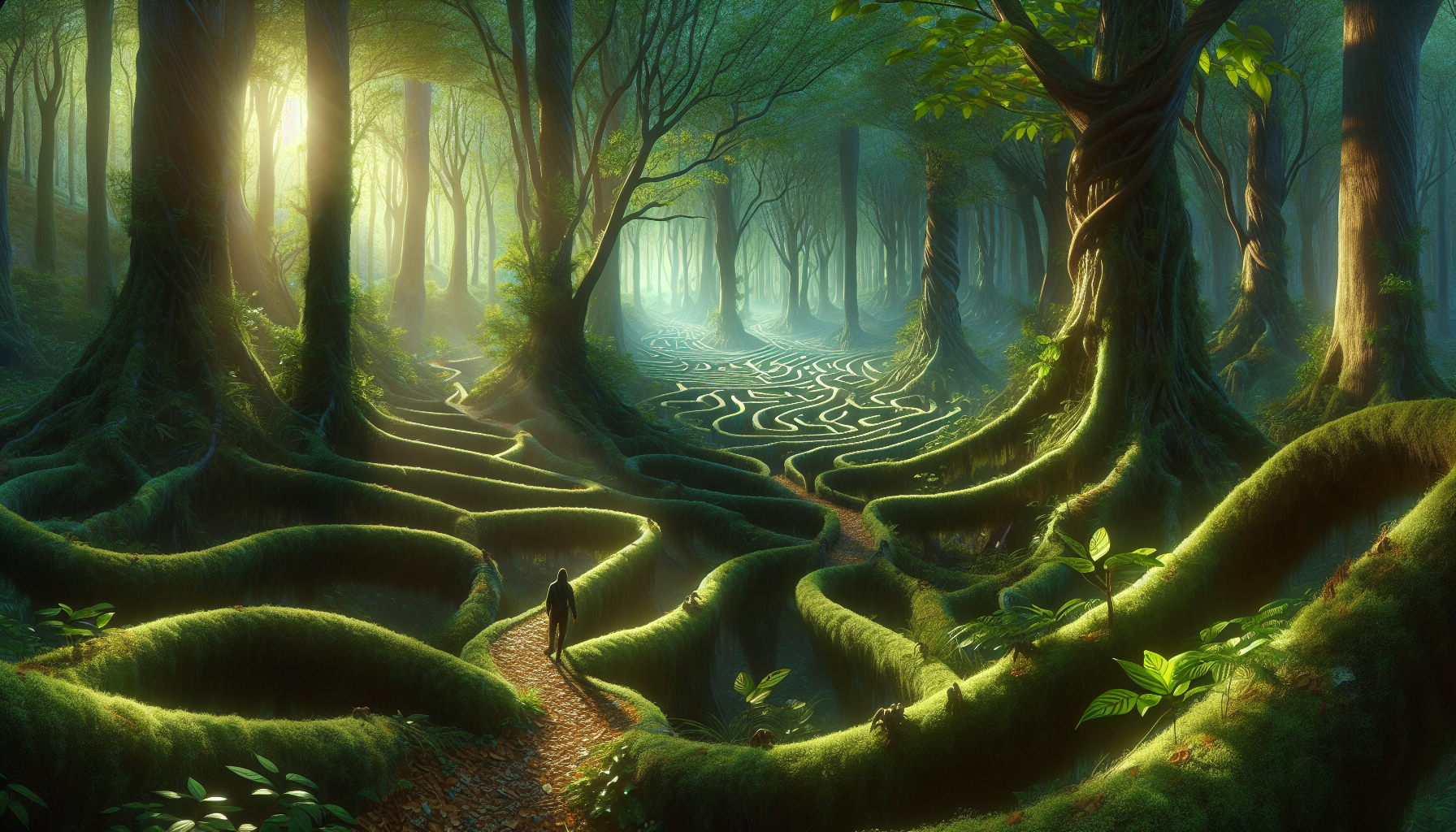In a world increasingly dominated by technology and urban landscapes, the allure of nature remains irresistibly potent, drawing us back to the wild with an almost magnetic pull. Forests, in particular, captivate our imagination, offering a refuge of tranquility and a playground of discovery. But beyond their serene beauty and apparent simplicity, forests harbor intricate networks and systems that mirror the complexities of our own minds. As we venture deeper into these verdant realms, we encounter not just a physical environment, but a cognitive maze—an enigmatic world that challenges our perception, enhances our creativity, and nurtures our mental well-being. 🌳✨
Imagine walking through a dense forest. The canopy above filters sunlight into a mosaic of greens and golds, while the air is rich with the scent of earth and foliage. Each step on the winding path is a venture into the unknown, a dance between the familiar and the unexpected. This sensory tapestry does more than delight the senses—it engages our brain in ways that are both ancient and profound. Studies have shown that being immersed in a natural environment can improve cognitive function, boost mood, and even increase problem-solving abilities. In this article, we will explore how forests act as cognitive mazes, challenging our minds and revealing the hidden depths of our mental faculties.
Forests as cognitive mazes offer us more than just a break from the urban jungle; they provide a unique setting for mental rejuvenation and intellectual stimulation. The complexity of forest ecosystems—with their myriad plants, animals, and microorganisms—parallels the intricate networks within our brains. As we navigate these labyrinthine landscapes, our minds are compelled to process vast amounts of sensory information, make quick decisions, and adapt to ever-changing conditions. This mental exercise not only sharpens our cognitive skills but also fosters creativity and innovation. Throughout this article, we will delve into the science behind these phenomena, uncovering how time spent in forests can lead to remarkable cognitive benefits.
As we embark on this journey through the intriguing world of forests, we will uncover the secrets of their impact on human cognition and creativity. From the ancient practice of forest bathing to modern research on nature therapy, we will examine the ways in which these natural sanctuaries can transform our minds. We’ll explore how forests challenge our perception, enhance our mental acuity, and inspire creative thought, all while providing a refuge from the stresses of modern life. So, lace up your hiking boots, open your mind, and get ready to discover the cognitive treasures hidden within the lush, green mazes of the world’s forests. 🌿🔍
The Enigmatic Labyrinth of Forests: A Cognitive Exploration
Forests have captivated human imagination for centuries. Their dense canopies and sprawling landscapes create a sense of mystery and wonder, drawing adventurers and researchers alike into their verdant depths. But forests are more than just picturesque sceneries; they are complex ecosystems that function as cognitive mazes, challenging and stimulating the human mind in unique ways. This exploration of forests as cognitive mazes delves into their role in fostering mental engagement, creativity, and a deeper understanding of the natural world.
The Cognitive Benefits of Navigating Forests
Forests are natural environments that inherently stimulate our cognitive abilities. The act of navigating through a forest, with its intricate network of paths and ever-changing landscapes, enhances spatial awareness and problem-solving skills. This form of navigation requires individuals to process a vast array of sensory information, integrating visual, auditory, and olfactory cues to form a mental map of the terrain. Such cognitive engagement can have profound impacts on mental health, reducing stress and enhancing creativity.
The restorative power of nature, particularly forests, has been well-documented in scientific studies. Spending time in these environments is associated with improved attention spans and heightened mental clarity. This phenomenon, often referred to as “attention restoration theory,” suggests that natural environments replenish our cognitive resources by providing a soothing and immersive experience that contrasts sharply with the overstimulation of urban settings. Forests, with their tranquil ambiance and rhythmic sounds, offer a sanctuary for the mind, allowing for reflection and introspection.
Moreover, forests challenge our cognitive processes through the necessity of decision-making and adaptability. As we traverse through these green labyrinths, we are constantly faced with choices—whether to follow a particular path, how to interpret natural landmarks, or how to respond to unexpected encounters with wildlife. These decisions require quick thinking and adaptability, skills that are transferable to various aspects of daily life.
Forests as Catalysts for Creativity
In addition to their cognitive benefits, forests serve as catalysts for creativity. The dynamic and multifaceted nature of these environments stimulates the imagination, encouraging creative thought and innovation. The varied textures, colors, and forms found in forests provide a rich tapestry that inspires artistic expression and creative problem-solving.
One of the key factors contributing to the creative potential of forests is the concept of “soft fascination.” Unlike urban environments, which often demand focused attention on specific tasks, forests offer a more passive form of engagement. This “soft fascination” allows the mind to wander freely, fostering creative connections and insights. The serenity of the forest provides a backdrop for introspection, where ideas can germinate and flourish.
Furthermore, the sensory richness of forests enhances creative thinking. The interplay of light and shadow, the symphony of natural sounds, and the tactile sensation of different plant textures stimulate the senses, encouraging a more holistic and imaginative approach to problem-solving. By engaging multiple senses, forests activate different areas of the brain, promoting the synthesis of new ideas and concepts.
The creative benefits of forests extend beyond individual experiences. Many artists, writers, and musicians have drawn inspiration from these natural landscapes, incorporating elements of the forest into their work. From the haunting melodies of classical compositions to the vivid imagery of landscape paintings, the influence of forests on human creativity is both profound and enduring.
Unlocking the Secrets of Forest Ecosystems
Forests are not only cognitive mazes for human exploration but also complex ecosystems teeming with life. Understanding the intricacies of these ecosystems requires a multidisciplinary approach, integrating knowledge from fields such as biology, ecology, and environmental science. This exploration unveils the symbiotic relationships between plants, animals, and microorganisms that sustain the delicate balance of forest life.
One fascinating aspect of forest ecosystems is the concept of the “wood wide web.” This underground network of mycorrhizal fungi connects the roots of trees and plants, facilitating the exchange of nutrients and information. Through this intricate web, trees communicate and support one another, demonstrating a level of interdependence that challenges our traditional understanding of individualism in nature.
The study of forest ecosystems also reveals the importance of biodiversity in maintaining ecological stability. Diverse plant and animal species contribute to the resilience of forests, enabling them to adapt to changing environmental conditions. The loss of biodiversity, often caused by human activities such as deforestation and habitat destruction, poses a significant threat to the health and sustainability of forest ecosystems.
| Aspect | Forests | Urban Environments |
|---|---|---|
| Cognitive Engagement | High, diverse sensory input | Focused, task-oriented |
| Creativity | Encourages free thought | Restrictive, structured |
| Biodiversity | Rich, complex ecosystems | Limited, artificial |
Forests as Platforms for Education and Awareness
The educational potential of forests is immense. They serve as living laboratories where individuals can learn about ecological processes, conservation efforts, and the importance of sustainability. By immersing themselves in these natural environments, people gain firsthand experience and knowledge that cannot be replicated in a traditional classroom setting.
Environmental education programs in forests provide opportunities for experiential learning, where students engage in hands-on activities such as plant identification, wildlife observation, and ecosystem restoration projects. These programs foster a deeper understanding of ecological concepts and instill a sense of stewardship and responsibility for the natural world.
Forests also play a crucial role in raising awareness about environmental issues. Through guided tours, interpretive trails, and interactive exhibits, visitors can learn about the threats facing forest ecosystems and the actions needed to protect them. This educational outreach helps bridge the gap between scientific research and public understanding, empowering individuals to make informed decisions and advocate for sustainable practices.
Engaging with Forests in the Digital Age
In today’s digital age, technology offers new avenues for engaging with forests and exploring their cognitive and ecological wonders. Virtual reality experiences and interactive apps provide immersive simulations of forest environments, allowing individuals to explore these natural landscapes from the comfort of their homes. These digital tools offer a unique perspective on forest ecosystems, highlighting their beauty and complexity while promoting environmental awareness.
Moreover, digital platforms facilitate citizen science initiatives, where individuals can contribute to scientific research by collecting data and observations from forests. These initiatives harness the power of collective intelligence, enabling researchers to gather large datasets and gain insights into forest dynamics on a global scale. By participating in citizen science projects, individuals become active contributors to the conservation and understanding of forest ecosystems.
The Future of Forests as Cognitive Mazes
As we continue to explore the cognitive and ecological dimensions of forests, it becomes increasingly important to prioritize their conservation and sustainable management. Forests face numerous challenges, including deforestation, climate change, and habitat fragmentation. Addressing these issues requires a collaborative effort that involves governments, organizations, and individuals working together to protect and restore these vital ecosystems.
Conservation initiatives focused on forest protection emphasize the importance of preserving biodiversity, safeguarding ecosystem services, and promoting sustainable practices. These efforts not only benefit the environment but also contribute to human well-being by ensuring the continued availability of forest resources and the cognitive and creative benefits they provide.
- Explore local forests and nature reserves to experience their cognitive benefits firsthand.
- Participate in environmental education programs to deepen your understanding of forest ecosystems.
- Engage with digital tools and citizen science projects to contribute to forest conservation efforts.
For a visual exploration of the cognitive wonders of forests, check out this insightful video titled “Forest Bathing: The Art of Mindful Walking in Nature” from the “Nature Therapy Channel” on YouTube: Forest Bathing Video

Conclusion
Title: Lost in Nature: Uncover the Intriguing World of Forests as Cognitive Mazes
In conclusion, our exploration into the fascinating concept of forests as cognitive mazes has illuminated several key aspects of this captivating topic. Throughout the article, we delved into how forests, often seen merely as natural reserves or sources of biodiversity, serve a much deeper purpose, acting as intricate mazes that engage and challenge our cognitive abilities.
Initially, we discussed the basic premise of forests as cognitive mazes. We examined how the complexity and vastness of forest landscapes are not just physical attributes but also cognitive challenges that require us to engage our problem-solving skills, memory, and spatial awareness. These natural environments push us to tap into our innate navigation abilities, much like ancient humans who relied heavily on such skills for survival.
Next, we explored the role of forests in enhancing mental health and cognitive function. The serene environment of forests provides a refuge from the chaos of urban life, allowing our minds to reset and rejuvenate. Studies have shown that spending time in forests can reduce stress, improve mood, and even boost creativity. By navigating through forest trails, individuals can enhance their memory and problem-solving abilities, demonstrating the remarkable impact of nature on our cognitive health.
The article also highlighted the educational potential of forests. Forests serve as living laboratories where individuals can learn about ecology, biology, and environmental science in a hands-on manner. They offer opportunities for experiential learning that can be more impactful than traditional classroom settings. Forests teach us about the interconnectivity of life, the importance of conservation, and the delicate balance of ecosystems, fostering a deeper appreciation for the natural world.
Moreover, we touched upon the technological advancements that are helping us understand forests better. From satellite imagery to drone technology, we now have tools that provide us with new perspectives on forest landscapes. These technologies not only aid in conservation efforts but also enhance our understanding of how forests function as cognitive mazes, offering insights into the patterns and structures that define these natural wonders.
The cultural significance of forests was another crucial point of discussion. Forests have been a source of inspiration for countless myths, legends, and artistic expressions throughout history. They are seen as symbols of mystery, adventure, and transformation. By engaging with forests, individuals can connect with these cultural narratives, enriching their understanding of human history and cultural heritage.
Reinforcing the importance of the topic, it becomes clear that forests are not just physical spaces but are deeply intertwined with our cognitive processes, mental health, education, technology, and culture. They challenge us to think critically, to navigate complexities, and to appreciate the intricate beauty of the natural world. As we continue to uncover the layers of what forests represent, we deepen our connection to nature and to ourselves.
In light of these insights, we encourage you, dear reader, to immerse yourself in the world of forests. Whether it’s through a hike in a nearby forest, participation in conservation efforts, or simply reading more about these fascinating landscapes, there are countless ways to engage with and appreciate forests. Share your experiences, insights, and thoughts with others to spread awareness and foster a community of nature enthusiasts who value the cognitive and cultural richness that forests offer.
Feel free to comment below with your thoughts on the cognitive challenges posed by forests or share your own experiences of getting “lost” in nature. We invite you to spread this knowledge by sharing this article with friends, family, or anyone who might find it intriguing. The more we understand and appreciate forests, the better equipped we are to protect them for future generations.
As we navigate through our own life mazes, let the forests remind us of the beauty and complexity that comes with every twist and turn. 🌳🧠
For further reading on the topics discussed in this article, you might find the following sources insightful:
– National Geographic: The Science of Nature and Mental Health
– World Wildlife Fund: Forest Conservation
– NASA Earth Observatory: Forest Observation from Space
Thank you for joining us on this journey through the cognitive mazes of forests. May your path through nature always lead to discovery and wonder.
Toni Santos is a visual storyteller and cognitive explorer whose work delves into the mental landscapes of ancient cultures—revealing how different civilizations perceived reality, memory, and meaning long before modern psychology existed. Through symbolic imagery and narrative inquiry, Toni brings to life the divergent ways of thinking that shaped lost worlds.
His creative path is guided by a fascination with non-linear logic, oral cosmologies, and the mythic frameworks that once guided decision-making, emotion, and identity. From memory temples carved in stone to visual languages encoded in textiles, every piece Toni creates reflects the vast cognitive diversity of the human story.
With a foundation in visual design and cultural semiotics, Toni blends analytical depth with artistic expression. His work goes beyond historical reconstruction—it reawakens the embodied, intuitive, and ritual-based intelligence of ancient minds, inviting us to question the assumptions of modern thought.
As the mind behind Vizovex, Toni curates visual studies, essays, and immersive content that explore forgotten epistemologies—ways of knowing that connected people to myth, land, and each other in profoundly different ways.
His work is a tribute to:
The symbolic intelligence of pre-modern cultures
The neural diversity embedded in ancient rituals and storytelling
The deep memory systems that shaped identity and perception
Whether you’re a researcher, an artist, or a seeker of hidden wisdom, Toni invites you to enter a space where cognition is culture, and where the past speaks through signs, cycles, and symbols—one myth, one memory, one mind at a time.





